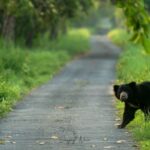If you’ve ever wandered through central India’s forests, you’ve probably passed a Mahua tree without realizing how much life is tied to it. Known scientifically as Madhuca longifolia, this tree is more than just a plant—it’s a provider, a healer, and even a part of the local identity.
For the forests and the people living within them, the Mahua offers sustenance and survival in ways that might surprise you.
Jump To
ToggleMahua: The Biological Backbone of the Forest
Mahua trees are an anchor in the tropical dry deciduous forests of states like Madhya Pradesh, Jharkhand, Chhattisgarh, and parts of Maharashtra. They grow at altitudes between 300 to 1200 meters, and you’ll often find them thriving in areas where other vegetation struggles. Mahua is incredibly drought-resistant, thanks to its deep-root system, which allows it to tap into underground water during the dry seasons.
When I think of Mahua, the first thing that comes to mind is how it’s a literal feast for the forest. During its flowering season, from March to May, the entire ground under the tree gets carpeted with pale-yellow blossoms, their sweet, heady fragrance drawing animals from every corner.
Wildlife love Mahua because of its flowers, fruit, and canopy. The flowers, which bloom between March and May, are rich in nectar, drawing creatures like sloth bears, elephants, deer, and even the small yet industrious bees. If you’re lucky enough to be there at the right moment, you might catch a family of langurs swinging through the branches, drawn by the scent.
These animals consume the fallen flowers that cover the forest floor like a pale-yellow blanket, offering energy-dense food when other resources are scarce. The sweet, sugary scent is irresistible to wildlife, making Mahua a reliable food source during the hot, dry months. Even the fruit—a fleshy berry-like structure—is consumed by pigeons, bulbuls, and various mammals.
Beyond feeding animals, Mahua also shades the forest floor, providing critical shelter for smaller creatures and reducing soil erosion—a significant benefit in regions prone to land degradation. It’s fascinating because the Mahua seems to create its own little ecosystem wherever it stands. Even the fallen flowers, instead of rotting away, become fodder for forest creatures and, later, fertile soil. It’s like the Mahua knows how to give and give without ever taking too much.
The Tree of Life with deep rooted human connections
Talk to any villager in the tribal belts of Chhattisgarh or Madhya Pradesh, and you’ll hear stories passed down through generations about the Mahua’s role in their survival. The connection runs so deep that during the flowering season, entire families camp out beneath the trees to collect the flowers. It’s a sight that feels almost timeless—baskets full of blossoms, carefully dried and stored for use throughout the year.
What happens next is a bit of alchemy: the flowers are fermented to make Mahua liquor. But this isn’t just any drink—this liquor is sacred, used in rituals, celebrations, and even as a traditional medicine. There’s an old saying in these villages that a house with Mahua never goes hungry. I’ve met elders who swear the liquor, when taken in moderation, has kept them healthy through their toughest winters.
Every Part of Mahua is Put to Use
The tree isn’t just useful for wildlife; humans use nearly every part of it:
Mahua Flowers – Mahua ke Phool
 The star of the Mahua tree. Once collected, these are sun-dried and used in various ways. Tribes and rural communities ferment them to produce Mahua liquor, a traditional alcoholic drink. The flowers are rich in sugar (up to 70%), and this is why they can be fermented with little effort. Besides being an essential part of local festivities and rituals, Mahua liquor has become a major source of income in these regions.
The star of the Mahua tree. Once collected, these are sun-dried and used in various ways. Tribes and rural communities ferment them to produce Mahua liquor, a traditional alcoholic drink. The flowers are rich in sugar (up to 70%), and this is why they can be fermented with little effort. Besides being an essential part of local festivities and rituals, Mahua liquor has become a major source of income in these regions.Seeds
Mahua seeds are packed with oil—each seed contains about 40-50% oil. This oil is extracted and used in cooking, soap-making, and traditional medicine. In rural India, Mahua oil is often used as a moisturizer and to treat skin ailments. Interestingly, the seed cake, left after oil extraction, is sometimes used as fertilizer or even in biogas production.Bark and Leaves
The bark is valued for its medicinal properties. In traditional healing practices, the bark is boiled to create decoctions that are said to relieve diabetes, bronchitis, and rheumatism. Meanwhile, leaves are often fed to livestock, and in some regions, they are used as compost or to make plates for serving food.Wood
While the wood of the Mahua is not particularly prized for high-end furniture, it’s commonly used for construction or fuel in rural areasFacts and Figures: The Mahua in Numbers
- Scientific name: Madhuca longifolia
- Height: Mahua trees can grow between 20-25 meters, with a broad canopy that spreads up to 10-15 meters.
- Flowering season: March to May, though it can vary slightly depending on the region.
- Seed oil content: The seeds yield 40-50% oil, which is used for cooking and medicinal purposes.
- Sugar content in flowers: Up to 70%, making it ideal for fermentation into liquor.
- Cultural relevance: In many tribal communities, Mahua flowers are collected and dried to sell in local markets, sometimes earning families up to Rs. 50,000-70,000 per year, depending on harvest conditions.
Challenges: Balancing Use and Sustainability
But here’s the tricky part: Mahua’s story is also one of vulnerability. For all the abundance it brings, the tree itself is under threat.
I once met a forest ranger in Odisha who told me that illegal logging and over harvesting are taking their toll. While the tree can handle droughts, human interference is a tougher challenge.
In some regions, people are so dependent on its flowers and seeds that they strip the tree bare, leaving little for wildlife or the next season.
The irony is that the communities most dependent on Mahua are also its greatest protectors. There’s a push in many villages to harvest sustainably—only taking what’s needed and ensuring the trees have a chance to recover.
I’ve heard of elders imposing informal “village rules” about when and how much to harvest, and these efforts are making a real difference.

Moreover, deforestation for agriculture and urban expansion has shrunk the Mahua’s habitat. I once spoke with a forest officer in Chhattisgarh, who explained that the push for more farmland is leading to the clearing of entire Mahua groves. As the Mahua trees disappear, so too do the animals that rely on them.
Climate change also poses a serious threat. Erratic rainfall patterns can disrupt the flowering season, affecting both the people and wildlife that rely on the tree. If the flowering happens too early or late, the ecosystem is thrown out of balance, and villagers lose a critical source of income and food security.
Local Insights: Mahua as the Center of Life
I remember visiting a village near Kanha Tiger Reserve, where the elders spoke about the Mahua as if it were part of the family. For them, the Mahua isn’t just a tree—it’s a partner in survival.
One elderly woman in particular spoke with pride about how, during the drought of 2002, it was the Mahua tree that kept the community afloat. “No crops, no rains, but there was always Mahua,” she said, her weathered hands resting on the tree trunk like an old friend.
The tree’s bounty isn’t just measured in rupees; it’s measured in stories, traditions, and the security it provides.
In some villages, there are strict communal rules on how much to collect, when to start, and when to stop, ensuring that both people and wildlife get their share. There’s a local saying: “Take what you need, leave what you don’t.” This unwritten code has been the backbone of sustainable harvesting for centuries.
How to Identify the Mahua Tree on Your Safari
For first-time safari goers in central India, spotting a Mahua tree (Madhuca longifolia) is a rewarding experience, especially once you know what to look for. Whether you’re in Madhya Pradesh, Chhattisgarh, or Odisha, this tree is a common presence in the dry deciduous forests. Here’s how you can recognize it during your safari:
- Look for the Tree’s Shape and Size
The Mahua tree is tall—it can grow up to 20-25 meters—with a thick, gnarled trunk and a broad, spreading canopy. Its large crown is unmistakable, often wider than other trees around it, giving ample shade beneath. The leaves are dark green and elliptical, with a leathery texture, clustered at the ends of the branches.
- Bark and Leaves
The Mahua’s bark is another useful indicator. It’s rough, greyish-brown, and often has deep fissures. On closer inspection, you may notice small resin deposits, which some people believe have healing properties. During March to May, when the leaves start to shed, the fresh new foliage is a vibrant reddish-green before turning dark green.
- Flowers: The Season of Scent
If you’re lucky enough to be on a safari in summer, you’ll notice a distinctive smell in the air—sweet and slightly fermented. That’s the fragrance of Mahua flowers, which bloom during this season. Guides often mention this as the “Mahua breeze”, a rich and unmistakable scent that fills the forest. It’s so potent that you’ll often detect the flowers before you even see the tree. These small, bell-shaped flowers have a pale yellow or creamy white hue and are scattered across the forest floor
- Fruits: The Mahua Berry
Later in the season, after flowering, Mahua produces a fleshy, greenish-yellow fruit, about the size of a plum. Though you might not see animals actively munching on these during your safari, pigeons, langurs, and other creatures enjoy these fruits. By spotting these fruits on the tree, you can be sure you’ve found a Mahua.
- The Ground Beneath the Tree
During the flowering season, the ground beneath the Mahua tree becomes a carpet of fallen blossoms. If you’re on a walking trail or stopping for a break, check the forest floor. You’ll often see clusters of pale yellow flowers or drying petals, which the locals collect for various uses. In fact, the sight of people gathering flowers at dawn is a common scene in Mahua-dense regions.
Conclusion
So, next time you’re on a safari, keep an eye—and nose—out for the Mahua tree. Its towering presence, distinctive bark, and especially the sweet, sugary scent of its flowers make it easy to identify once you know what to look for. By recognizing Mahua, you’ll not only enjoy a richer safari experience but also deepen your connection with the forest and its intricate web of life.
The Mahua tree, Madhuca longifolia, is a prime example of nature’s generosity. It nurtures wildlife, sustains local communities, and holds deep cultural value. Yet, as human demands grow and environmental pressures increase, the Mahua’s future hangs in the balance. To ensure it continues to thrive, both for the elephants and the tribal families that rely on it, we must protect its habitat, promote sustainable harvesting, and listen to the wisdom of those who have lived alongside it for generations. In Mahua, we find not just a tree but a way of life.



























